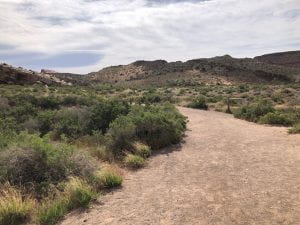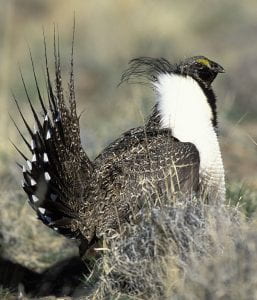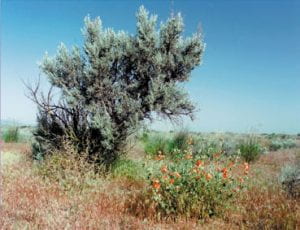(Click on the following link to listen to an audio version of this blog … Sagebrush )
When we drove out of the Rocky Mountains via Glenwood Canyon, we entered the sagebrush lands of Colorado Plateau. Big sagebrush (Artemisia tridentata) is one of the more notable species of sagebrush found all across these arid, western plains. Sagebrush is not technically a desert plant, though, instead, it is considered to be a vital member of the dry, steppe plant community (steppes receive slightly more rain (7 to 16 inches per year) than deserts (which receive less than 10 inches of rain per year). Sagebrush is found from Nebraska to California and from New Mexico to Montana. It has the widest distribution of any shrub in North America.
There is a wide range of estimates of the area of western North America that was once covered with sagebrush. A frequently mentioned value, though, is 422,000 square miles (270 million acres), a very large chunk of the American west! Regardless of how much sagebrush we started with, though, most experts agree that to date, more than half of the original, pre-settlement sagebrush acreage has been lost primarily due to land clearing for agriculture and various range “improvements” for livestock forage. Also, unnaturally extensive and intense wildfires, driven in part by climate change, have also destroyed millions of acres of sagebrush (more on this below).
Big sagebrush (and other sagebrush species) were once classified as an undesirable “range weeds” by the United States Department of Agriculture (USDA), and land managers were encouraged to eradicate them. More recently, however, the true nature of sagebrush has come to light. The presence of these tall, evergreen shrubs in their arid habitats, generates microenvironments under them, within them and around them that are favorable and sometimes even vital for the existence of hundreds of species of plants and animals. Big sagebrush is, quite decidedly, a keystone species in its biological community!
Writing in a series of USDA Technical reports in the early 2000’s, B. L. Welch compared the soil and plant communities under or near sagebrush with those away from the sagebrush cover and noted that in the proximity of sagebrush, plant diversity and abundance were higher, soil moisture and nutrient levels were higher and the growing season for plants was 28 days longer.
Welch further listed animals that were obligatorily dependent on sagebrush for their survival (including the greater sage grouse, Gunnison’s sage grouse, sage sparrow, Brewer’s sparrow, sage thrasher, pygmy rabbit and sagebrush vole). He also noted that 100 species of birds, 90 species of mammals, 60 species of reptiles and amphibians are at least partially dependent on sagebrush for food, habitat, reproductive sites and as a refuge from the extreme heat of the dry steppe environment. Also, 240 species of insects, 70 species of spiders and other arachnids, 133 species of plants (including 23 species of root hemi-parasitic paintbrushes and owl-clovers) and 24 species of lichen were associated with and benefited by sagebrush. He also described the synergy between the sagebrush micro-community and the surrounding, soil surface “biological crust.” (We will talk about biological crusts next week!)
Big sagebrush gets its species name (“tridentata”) from its three-pronged leaves. The leaves are small and are directly attached to nodes on its stem. They are also covered with fine, silvery hairs. The small size, the tight stem attachments and the covering hairs all help to reduce transpiration water loss from the leaves and increase the fitness of the plant in its very dry environment.
Big sagebrush can be a foot and a half to over nine feet tall depending on the richness and, especially, the moisture levels of its soil. Big sagebrush can also have a very long lifespan with some plants reaching 100 years of age! Big sagebrush has two types of roots: a dense shallow set that quickly gathers any incoming precipitation from the surrounding soil surface, and a deep taproot that reaches down 3 to 15 feet often reaching the underlying water table. These tap roots brings up “deep water” that not only satisfies the sagebrush’s own water needs but also provides moisture to nearby plants. European settlers looking to establish farms in the dry steppes of the American southwest, looked for tall, big sagebrush as indicators of a deep, non-acidic soils with, potentially, high soil fertility.
Big sagebrush’s silver-grey leaves have an herbal, almost spicy aroma due to an abundance of secondary chemicals like camphor, terpenoids and a number of other volatile oils. The purpose of these chemicals is to protect the leaves from grazers and browsers and also, possibly, to serve as communication chemicals between plants (when a sagebrush is disturbed by a grazer, it releases a cloud of camphor and terpenoids which stimulate nearby plants to make more of these grazer-repellant chemicals).
Big sagebrush leaves are rich in protein (16%), fats (15%) an carbohydrates (47%) and are actually more nutritious than alfalfa! Domestic livestock, though, is not able to consume big sagebrush because of its volatile chemicals. This intolerance explains why many ranchers have treated sagebrush as a noxious weed! A number of native species (like deer, moose, elk, and especially, pronghorns and bighorn sheep) can, at need, eat big sagebrush leaves especially in the winter. One reference stated that these native species “belch off” the volatile secondary chemicals before they can poison their vital, mutualistic, gut bacteria. Sage grouse also readily eat sagebrush leaves (sagebrush leaves make up 60 to 80% of the sage grouses’ year-round diet). The absence of gizzard in the sage grouse, apparently, allows the sagebrush leaves to pass through their digestive systems without excessive physical disturbance that would release the toxic, volatile chemicals from the leaf tissues.
The flowers of big sagebrush develop on stalks that rise up from its upper branches. The flowers are small, yellow and wind pollinated. Pollen is produced in great quantities in August and September and is a very well recognized cause of fall allergies. Abundant seeds are produced as a consequence of this pollination (up to 350,000 per plant). Seeds are dispersed by gravity and wind and also by ants (in particular, the western harvester ant (Pogonomyrex occidentalis)). Native Americans harvested the very abundant big
sagebrush seeds and ground them to make a flour.
Sagebrush is able to reproduce both by seed and also by stem-sprouting from its underground rhizome. New plants arising from seed require much higher amounts of moisture than plants arising from root sprouts. The “mother” plant of these sprouts, apparently, provides both water and nutrients to its clonal offspring giving them a growth edge over seed-derived, sagebrush seedlings and also other plants. Seed dispersal into burn areas, however, is vital for sagebrush recovery following a wildfire.
Fire is a normal component of a natural sagebrush ecosystem. The abundance of oils in the tissues of sagebrush plants make them extremely flammable even when they are green and healthy. “Natural” fires, though, in a sagebrush community are usually rather limited in total land area that is burned, and they are of rather low, overall intensity. These “natural” fires historically occurred every 60 to 110 years, and once an area burned, it was quickly re-seeded with sagebrush from nearby, surrounding plants. The cycling of these natural fires created natural sagebrush ecosystems that were patchworks of differentially aged communities. It also kept the vegetative systems in sagebrush configurations. Suppression of these natural wildfires through human intervention, however, broke this ecological re-set pattern and caused aging, sagebrush communities to be replaced via succession by woodlands of pinyon pine and juniper. Millions of acres of sagebrush have been lost to pinyon-juniper forests because of the human interference in the natural fire cycle.
Modern fires in sagebrush habitats are quite different from historical, natural fires. Climate change has caused prolonged drought periods and elevated summer temperatures throughout the west. These conditions have caused the sagebrush vegetative community to become very dry over very extended periods of time. Also, the modern sagebrush plant community now includes a number of invasive plant species that add considerably to the overall quantity of fuel available to support and feed a wildfire. In particular, the exotic invasive “cheat grass” (Bromos tectorum) is found abundantly throughout sagebrush areas. Cheat grass was accidently introduced to wheat fields in the United States in the late 19th Century and has spread widely and rapidly across the west. When we were in Utah we saw cheat grass growing in the vegetative communities throughout the national parks. We even saw waves of cheat grass growing up through the dry, barren gravel of a number of parking areas! It is a tenacious and highly drought-tolerant weed!
Cheat grass- assisted wildfires burn much hotter than “natural” wildfires. They also burn over much more extensive areas. These expanded burn areas, then, are not efficiently re-seeded with sagebrush because of the greater distance the poorly transported sagebrush seeds must travel. Also, because these cheat-grass assisted fires occur much more frequently than natural fires (the new fire cycle repeats itself, on average, every 5 years!) they eliminate any early, vegetative re-growth and very effectively prevent the sagebrush community from becoming re-established. Sagebrush, amazingly, is under a distinct extinction threat from these climate and invasive species augmented fires!








